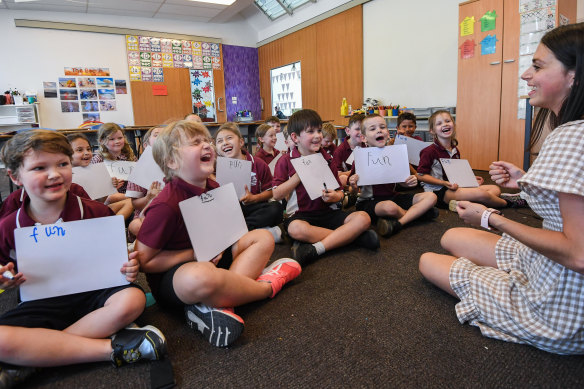By Adam Carey
Four years ago Churchill Primary had, in the words of its principal, “far too many kids who were really not able to read”.
The small, disadvantaged school in the Latrobe Valley had persisted for years with an approach known as balanced literacy, with its mix of levelled readers and traditional children’s storybooks as reading tools, but achieved stubbornly poor results.

Churchill Primary School teacher Lina D’Alia uses phonics to teach year one students to read. Credit: Joe Armao
Tired of seeing so many children leave the school with low literacy, principal Jacquie Burrows abandoned balanced literacy for a “purist” phonics-based approach.
What followed was a remarkable turnaround in the school’s NAPLAN data.
In 2018, when the school began its change, 31 per cent of grade 3 students were in the bottom two NAPLAN bands for reading and just 17 per cent were in the top two bands.
Last year, not a single student was in the bottom two bands for reading and 75 per cent were in the top three bands, well above the state average of 60 per cent. The average among schools with a similar profile to Churchill Primary is 41 per cent.
Similarly, big advances were made in the school’s writing, spelling and grammar results.
Synthetic phonics teaches children the 44 sounds, or phonemes, in the English language and the letter combinations that make them. It breaks written language down into small and simple components.
In balanced literacy, students are taught to memorise words using a combination of whole language practices and phonics. Whole languages teach children to read by recognising full words and phrases by encountering them in text.
Ms Burrows said she struggled at times to purge the school of its established way of teaching children to read. It was expensive to retrain teachers, and there were few local experts to call on for advice on how to do it.
“It was lonely at times because there was such an embedded approach to literacy around whole language, and that’s the way our teachers had been taught at university,” she said.
“So it was hard, but our results came really quickly.”
Churchill Primary is one of relatively few schools in Victoria that have switched to systematic synthetic phonics to the exclusion of other more widely established literacy techniques.
In so doing, these schools have foreshadowed a shift in the science of teaching children to read that all schools are being urged to adopt in a new Australian curriculum that is up for review.
The draft curriculum, which is due to be considered by education ministers for a third time in April, has elevated the role of phonics in early primary years education, at the expense of so-called whole language approaches that comprise much of the balanced literacy approach.
If it is endorsed in its current form, it could put pressure on Victoria to lift the primacy of phonics in schools.
Other states have already raised phonics’ place in their curricula, including NSW, which will mandate its use in the first three years of primary school from next year.
South Australia, meanwhile, has mandated a year one phonics screening check for all students to test literacy levels.
Victoria has taken a less prescriptive approach, giving schools and teachers significant autonomy to select their literacy programs.
Glenn Fahey, research fellow in education policy at the Centre for Independent Studies, said: “You would hope that the direction that everyone is going nationally would be a wake-up call for Victorian policymakers, because they have dragged the chain on the national reform agenda in the area of reading and the instruction around it.”
Emina McLean, a literacy expert, lecturer and senior researcher, said the Victorian government’s “hands-off” approach created a lot of variability between schools.
“It’s absolutely necessary and positive and overdue that phonics is being elevated, but what that looks like in practice is a totally different thing,” Ms McLean said of the proposed curriculum overhaul.
“Phonics might be taught in one school with a degree of explicitness and in another school it’s only taught within the context of storybook reading.”
The outcome, argues Ms McLean, who also leads English and literacy in a Victorian government primary school, is that some schools are having much more success than others in teaching children to read.
Western Sydney University lecturer Dr Katina Zammit, president of the Australian Literacy Educators’ Association, argues balanced literacy has its own evidence base to suggest it should not be discarded as a literacy technique.
Phonics has its limitations, particularly for advanced students who need to be stretched in their early years of school, she says.
“It’s very important that you are providing the most appropriate reading material for the development of the child.”
Decodable phonics-based texts, with their focus on sounds at the expense of storyline, also risk undermining a child’s delight in reading, Dr Zammit argues.
“You may have children coming to school with a well-developed sense of phonemic awareness – asking them to read decodable texts is going to turn them off wanting to read.”
An Andrews government spokesperson said Victoria already had phonics assessment in place for primary school students that provides a picture of each student’s early literacy skills.
“We’ll continue to enhance the way we teach and assess phonics across the Victorian curriculum to make sure every student gets the best early literacy skills to set them up for success throughout their schooling,” the spokesperson said.
The Morning Edition newsletter is your guide to the day’s most important and interesting stories, analysis and insights. Sign up here.